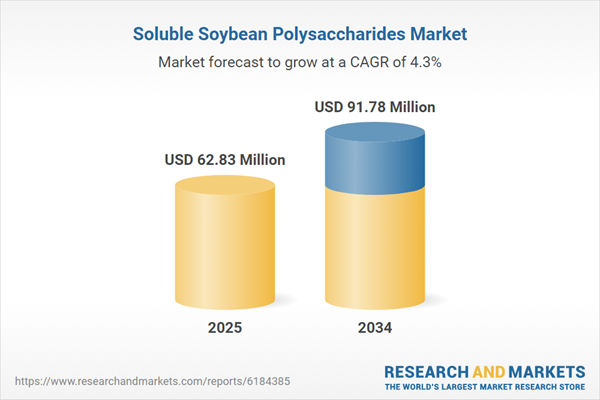Soluble Soybean Polysaccharides Market
Soluble soybean polysaccharides (SSPS) are functional dietary fibers extracted from soybean cotyledons, valued for their unique ability to stabilize proteins in low-pH, heat-treated beverages. Unlike many hydrocolloids, SSPS offers low viscosity at use levels while providing robust steric stabilization of casein and plant proteins through acid, shear, and thermal stress - making it the workhorse in acidic dairy drinks, RTD coffees with milk, fruit-yogurt beverages, and emerging protein-fortified juices. Additional end-uses span fermented dairy drink bases, shelf-stable smoothies, plant-based creamers, high-protein shots, and select confectionery/icing systems where gloss retention and freeze-thaw stability are valued. Trends include rapid expansion of RTD coffee/tea with dairy, sugar-reduced fruit-dairy blends that demand clarity and no sediment, and cross-over into plant-protein beverages where SSPS mitigates aggregation with calcium and polyphenols. Clean-label demand favors “soy dietary fiber” positioning, non-GMO identity preservation, and allergen-aware declarations. On the supply side, producers invest in enzymatic extraction control, color/odor minimization, and instantized powder technologies for cold-water dispersion. The competitive landscape comprises specialty hydrocolloid houses and soy-value-chain players offering SSPS grades tailored to pH windows, mineral systems, and thermal profiles; many provide application kits for UHT/ESL lines and aseptic fillers. Differentiation centers on dose efficiency, clarity, low off-notes, and consistent performance across variable acid and calcium loads. Key challenges include soy allergen labeling requirements, regional fiber-claim nuances, and price sensitivity versus pectin or CMC in certain matrices. Overall, SSPS has moved from a niche stabilizer to a strategic enabler for modern, protein-forward, shelf-stable beverages demanding low viscosity with high stability.Soluble Soybean Polysaccharides Market Key Insights
- Protein stabilization at low pH is the killer app. SSPS forms a protective layer around casein and plant proteins, preventing flocculation in pH ~3.5-4.5 under UHT and homogenization. It outperforms many gums where viscosity must remain drinkable, enabling clear, stable acidic dairy and fruit-dairy beverages with long ambient shelf life.
- Low viscosity, high functionality. Unlike pectin-based systems, SSPS achieves stabilization at modest viscosities, preserving “light” mouthfeel demanded by modern RTD formats. This allows higher juice or coffee solids without a heavy texture and maintains drinkability in larger portion sizes.
- Mineral and polyphenol tolerance. SSPS handles calcium and polyphenol loads in coffee/tea and fortified juices better than many alternatives. Blends with citrate/phosphate buffers fine-tune performance, supporting enriched SKUs (added calcium, electrolytes) without haze or sediment.
- Plant-protein adoption accelerates use. As brands push pea/soy/almond/oat proteins into acidic matrices, SSPS mitigates aggregation after UHT and during storage. Pairing with controlled homogenization and late-stage acidification broadens the window for stable, high-protein fruit acids and coffee drinks.
- Process-robust grades and instantization. Agglomerated and cold-water dispersible SSPS reduces fish-eyes and cuts hydration time at scale. Grade selection matches heat profiles (HTST vs UHT), solids, and pH targets, reducing line downtime and variability across co-packers.
- Clarity and flavor neutrality matter. Premium RTD coffees and fruit-dairy blends demand low color and minimal beany notes. Suppliers optimize deodorization and ash control, helping maintain true coffee/fruit aromatics and clean label flavor systems.
- Cost-in-use vs pectin/CMC is context-specific. Where low viscosity and protein stabilization are both required, SSPS can be more dose-efficient than pectin; in non-protein acidic drinks, alternatives may be cheaper. Decision frameworks consider dose, solids, mineral load, and target mouthfeel.
- Regulatory and labeling diligence. Positioning as “dietary fiber” varies by market, with soy allergen declarations mandatory. Brands align serving sizes and claims to local fiber definitions, and deploy clear consumer language on stability benefits without implying therapeutic effects.
- Sustainability and IP supply chains. Identity-preserved, non-GMO soy and responsible agriculture programs are increasingly requested by retailers. Producers report on water/energy intensity and develop mono-material packaging for ingredient bags to support downstream ESG goals.
- Application toolkits drive speed-to-market. Winning suppliers provide pH/calcium challenge tests, pilot-plant SOPs, and template recipes (e.g., coffee-milk pH 6→3.9 acidification) to cut commercialization cycles and de-risk co-packer transfers.
Soluble Soybean Polysaccharides Market Reginal Analysis
North America
Growth is driven by RTD coffee with milk, protein-fortified fruit-dairy drinks, and better-for-you smoothies. Brands value SSPS for low viscosity and shelf stability through ambient distribution. Non-GMO identity preservation, allergen clarity, and batch-level certificates are table stakes. Co-manufacturers seek instantized grades to reduce hydration time and improve first-pass yields on UHT/aseptic lines.Europe
Premium coffee and yogurt-drink segments prioritize clean label and sensory neutrality. Fiber-claim rules and allergen labeling shape front-of-pack language. SSPS competes with pectin in non-protein fruit beverages but wins in protein-acid matrices where clarity and drinkability are critical. Retailers increasingly request sustainability documentation and recyclable packaging for bulk ingredients.Asia-Pacific
A historic base for acidic dairy drinks continues to expand, alongside booming RTD tea/coffee with milk. Local expertise in acidified protein beverages favors SSPS adoption across national brands and convenience channels. Rapid product cycles and cross-border e-commerce spur demand for consistent grades, with strong technical support for high-temperature, high-solids processes.Middle East & Africa
Rising demand for ambient dairy drinks and coffee beverages in GCC modern trade benefits SSPS. Heat-resilient stability, low viscosity, and reliable hydration are key in warm chains. Importers emphasize allergen transparency and halal documentation. Education for regional co-packers on pH-down protocols and calcium management accelerates adoption.South & Central America
Fruit-dairy drinks and café-style RTDs gain traction in urban retail and convenience channels. SSPS is favored where stable protein and light mouthfeel are required through hot-fill or UHT. Distributors prioritize cost-in-use, cold-water dispersibility, and steady supply amid currency and logistics volatility, with bilingual labels and simple SOPs aiding plant execution.Soluble Soybean Polysaccharides Market Segmentation
By Type
- Soybean Polysaccharides -A
- Soybean Polysaccharides -B
By Application
- Rice and Flour
- Drinking
- Biomedicine
- Others
Key Market players
Archer Daniels Midland Company (ADM), Cargill, Incorporated, Ingredion Incorporated, Kerry Group plc, Roquette Frères, International Flavors & Fragrances Inc., Royal DSM N.V., Döhler GmbH, Fuji Oil Group, Weibo, HuaHui Biological, Shanghai Biotech (Shahghai Biotech), Jinjing Biotechnology, Juyuan, BASF SESoluble Soybean Polysaccharides Market Analytics
The report employs rigorous tools, including Porter’s Five Forces, value chain mapping, and scenario-based modelling, to assess supply-demand dynamics. Cross-sector influences from parent, derived, and substitute markets are evaluated to identify risks and opportunities. Trade and pricing analytics provide an up-to-date view of international flows, including leading exporters, importers, and regional price trends.Macroeconomic indicators, policy frameworks such as carbon pricing and energy security strategies, and evolving consumer behaviour are considered in forecasting scenarios. Recent deal flows, partnerships, and technology innovations are incorporated to assess their impact on future market performance.
Soluble Soybean Polysaccharides Market Competitive Intelligence
The competitive landscape is mapped through proprietary frameworks, profiling leading companies with details on business models, product portfolios, financial performance, and strategic initiatives. Key developments such as mergers & acquisitions, technology collaborations, investment inflows, and regional expansions are analyzed for their competitive impact. The report also identifies emerging players and innovative startups contributing to market disruption.Regional insights highlight the most promising investment destinations, regulatory landscapes, and evolving partnerships across energy and industrial corridors.
Countries Covered
- North America - Soluble Soybean Polysaccharides market data and outlook to 2034
- United States
- Canada
- Mexico
- Europe - Soluble Soybean Polysaccharides market data and outlook to 2034
- Germany
- United Kingdom
- France
- Italy
- Spain
- BeNeLux
- Russia
- Sweden
- Asia-Pacific - Soluble Soybean Polysaccharides market data and outlook to 2034
- China
- Japan
- India
- South Korea
- Australia
- Indonesia
- Malaysia
- Vietnam
- Middle East and Africa - Soluble Soybean Polysaccharides market data and outlook to 2034
- Saudi Arabia
- South Africa
- Iran
- UAE
- Egypt
- South and Central America - Soluble Soybean Polysaccharides market data and outlook to 2034
- Brazil
- Argentina
- Chile
- Peru
Research Methodology
This study combines primary inputs from industry experts across the Soluble Soybean Polysaccharides value chain with secondary data from associations, government publications, trade databases, and company disclosures. Proprietary modeling techniques, including data triangulation, statistical correlation, and scenario planning, are applied to deliver reliable market sizing and forecasting.Key Questions Addressed
- What is the current and forecast market size of the Soluble Soybean Polysaccharides industry at global, regional, and country levels?
- Which types, applications, and technologies present the highest growth potential?
- How are supply chains adapting to geopolitical and economic shocks?
- What role do policy frameworks, trade flows, and sustainability targets play in shaping demand?
- Who are the leading players, and how are their strategies evolving in the face of global uncertainty?
- Which regional “hotspots” and customer segments will outpace the market, and what go-to-market and partnership models best support entry and expansion?
- Where are the most investable opportunities - across technology roadmaps, sustainability-linked innovation, and M&A - and what is the best segment to invest over the next 3-5 years?
Your Key Takeaways from the Soluble Soybean Polysaccharides Market Report
- Global Soluble Soybean Polysaccharides market size and growth projections (CAGR), 2024-2034
- Impact of Russia-Ukraine, Israel-Palestine, and Hamas conflicts on Soluble Soybean Polysaccharides trade, costs, and supply chains
- Soluble Soybean Polysaccharides market size, share, and outlook across 5 regions and 27 countries, 2023-2034
- Soluble Soybean Polysaccharides market size, CAGR, and market share of key products, applications, and end-user verticals, 2023-2034
- Short- and long-term Soluble Soybean Polysaccharides market trends, drivers, restraints, and opportunities
- Porter’s Five Forces analysis, technological developments, and Soluble Soybean Polysaccharides supply chain analysis
- Soluble Soybean Polysaccharides trade analysis, Soluble Soybean Polysaccharides market price analysis, and Soluble Soybean Polysaccharides supply/demand dynamics
- Profiles of 5 leading companies - overview, key strategies, financials, and products
- Latest Soluble Soybean Polysaccharides market news and developments
Additional Support
With the purchase of this report, you will receive:- An updated PDF report and an MS Excel data workbook containing all market tables and figures for easy analysis.
- 7-day post-sale analyst support for clarifications and in-scope supplementary data, ensuring the deliverable aligns precisely with your requirements.
- Complimentary report update to incorporate the latest available data and the impact of recent market developments.
This product will be delivered within 1-3 business days.
Table of Contents
Companies Mentioned
- Archer Daniels Midland Company (ADM)
- Cargill
- Incorporated
- Ingredion Incorporated
- Kerry Group PLC
- Roquette Frères
- International Flavors & Fragrances Inc.
- Royal DSM N.V.
- Döhler GmbH
- Fuji Oil Group
- HuaHui Biological
- Shanghai Biotech (Shahghai Biotech)
- Jinjing Biotechnology
- Juyuan
- BASF SE
Table Information
| Report Attribute | Details |
|---|---|
| No. of Pages | 160 |
| Published | November 2025 |
| Forecast Period | 2025 - 2034 |
| Estimated Market Value ( USD | $ 62.83 Million |
| Forecasted Market Value ( USD | $ 91.78 Million |
| Compound Annual Growth Rate | 4.3% |
| Regions Covered | Global |
| No. of Companies Mentioned | 16 |









